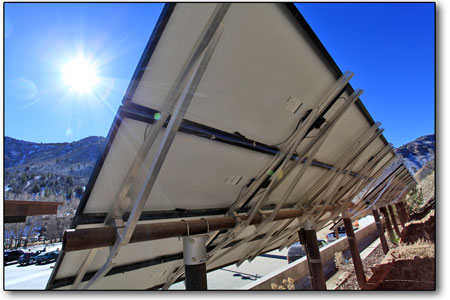 |
|
Since 2004, state residents have been paid incentives for installing renewable energy systems such as this. However, with the increase in popularity of solar arrays as well as the continued cost of upkeeping the grid, some utility companies are reducing the amount they pay people for such power./Photo by Steve Eginoire. |
Price of solar becomes a hot topic
State agency hears debate on reducing renewable energy credits
by Tracy Chamberlin
What’s it really worth? When Colorado residents take the time and money to install solar panels or join a community solar garden, how much money should they get for each kilowatt generated and sent back to the grid?
That’s the question before the Colorado Public Utilities Commission.
It’s certainly not a new question. Since net metering, an electric service that allows participants to earn credits for solar power generation, was first established in Colorado in 2004, those for and against have debated how much to pay for the energy sent back to the grid. At issue was the actual cost of using and maintaining that grid versus a desire to encourage solar energy investments.
A decade later, solar investments are high and continue to rise. Therefore, some think it’s time to start drawing down on that encouragement in the form of subsidies and credits, while others believe its still worth paying top dollar.
The debate between these two sides has heated up in recent months, inflamed by a plan put forth by Xcel energy. Every two years Xcel, an electric utility that services communities in eight states, submits a Renewable Energy Standard Compliance Plan to Colorado’s Public Utilities Commission, or PUC, for approval.
This year’s plan includes language that would cut the incentives paid to customers, as well as a way to clearly state all the costs and payments involved.
Currently, Xcel pays 10.5 cents per kilowatt hour but claims it’s really only worth about 4.5 cents. Most of that difference comes from the funds needed for upkeep and maintenance of the grid, the same grid that the owners of solar systems are utilizing but not paying for. The utility argues the cost of that maintenance is therefore passed onto the customers who perhaps can’t afford to install solar systems.
In its filing, Xcel argued that the incentives for net metering are higher than the actual value of the energy produced. For some, that’s fine. They argue encouraging a renewable energy system, like solar power, is worth the cost.
After Xcel originally filed the plan, the Colorado Energy Office, a state agency tasked with promoting efficient use of the energy resources, filed a motion asking the PUC to split the issue and the debate over net metering from its decision over 4 whether or not to approve the utility’s plan.
“Severing the issues related to net metering … would increase transparency and allow stakeholders from across the state to participate in the dialog related to incremental costs, net metering incentives, and solar energy rates,” the motion reads.
The PUC approved that request Jan. 29, just days ahead of a public hearing on Xcel’s plan, essentially untying it from an official decision over net metering and putting it off for another day.
Of course, that wasn’t the last word in the debate.
Many proponents and opponents still insist that the PUC’s decision on Xcel will set the tone. And many arrived at the commission’s hearing room on Mon., Feb. 3, to speak their piece about net metering.
Some attendees spoke about personal experiences as customers of Xcel who were benefitting from the current net-metering program. Others commented on solar power subsidies and suggested a “phased-out” approach.
One attendee, who was not a customer of Xcel, said that although the utility company serving his area was not regulated by the PUC, he agreed that the commission’s decision would reverberate across Colorado and influence the future of renewable energy credits.
The utility provider for Southwest Colorado, La Plata Electric Association, is also not directly regulated by the PUC. The electric coop makes its own decisions about the price for renewable energy credits, or RECs. LPEA still reports to the PUC but is not required to get approval on such decisions.
According to LPEA CEO Greg Munro, this means that the commission’s decision on Xcel would likely have no affect on the coop and its members.
What does affect local conditions, though, is the market value of RECs. Munro said the greatest impact on that value is the actual price of solar panels, something that’s been on the decline. And taking the REC with it.
In 2012, the coop paid $400 per kilowatt for one REC. Last year, that amount dropped to $300. So, LPEA decided to find another way to boost the credit.
LPEA turned to the Local Renewable Generation Fund, made up of LPEA member contributions in an effort to support local renewable energy. That fund has been used in the past to pay for solar panels on local schools like Miller Middle School in Durango.
Using those monies to add $50 per kilowatt, the coop’s Board of Directors voted in December to increase the REC to $350 in 2014 in hopes of encouraging “more LPEA members to look into installing renewable systems,” according to LPEA.
And perhaps it’s working. Like much of Colorado, the number of solar systems in Southwest Colorado continues to rise. Last year, LPEA had 477 net metered accounts in its service area. A couple of those were wind, but most were solar. So far this year, LPEA already has 15 to 20 undergoing the inspection process.
Although LPEA has more say in the cost of renewable energy credits than Xcel Energy, that amount is still in flux. Each year, LPEA – in concert with TriState Generation, its power supplier – must consider all the market factors and decide how much RECs are worth for that year.
It’s the same question before the state’s Public Utilities Commission.
